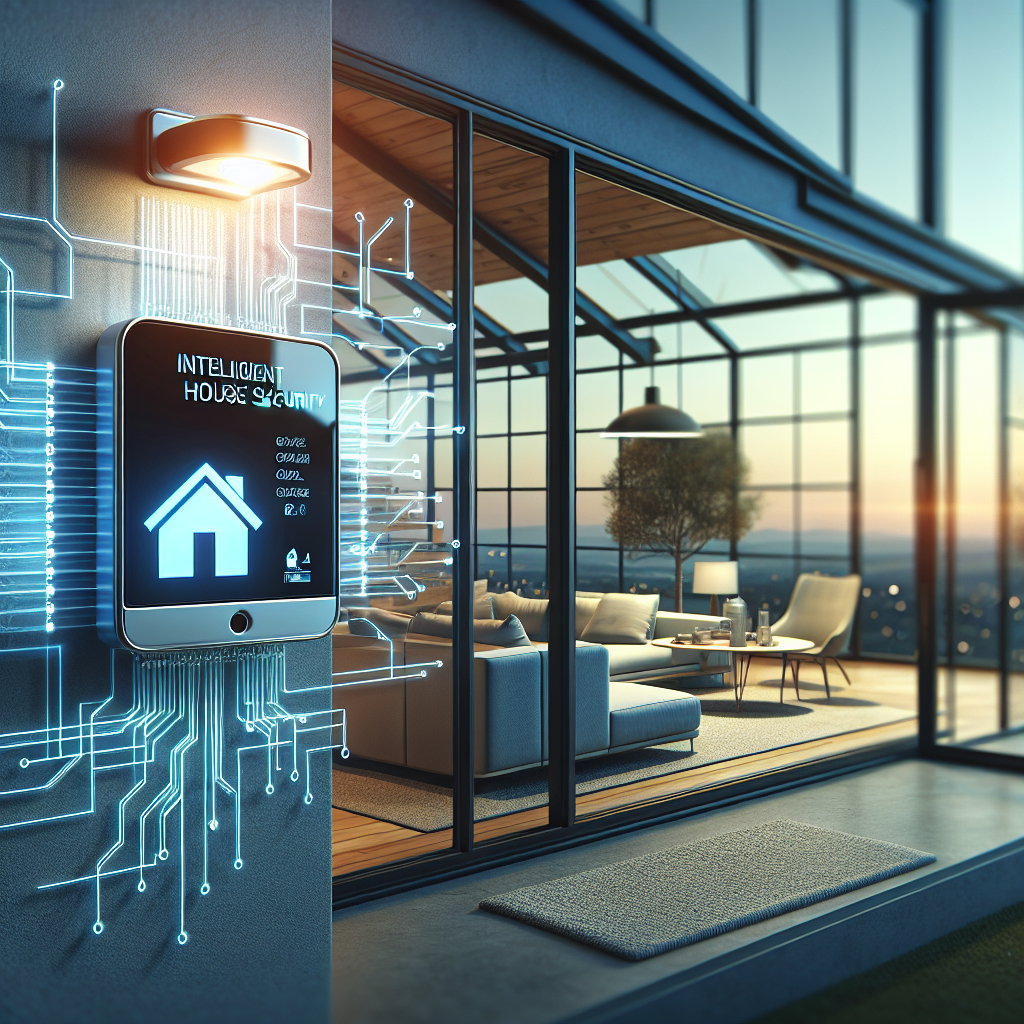In the contemporary era of connected living, the need for a reliable security system has never been more pressing. Introducing the next generation of smart home protection – a groundbreaking security system equipped with a cutting-edge glass break sensor. This innovative technology not only detects the sound of broken glass but also provides real-time alerts to your smartphone, ensuring ultimate peace of mind when it comes to safeguarding your home. Experience the convenience and assurance of a smart home security system that goes above and beyond in keeping your household safe and secure. Elevate your home security to the next level with our state-of-the-art solution.
Understanding Smart Home Security Systems
Smart home security systems refer to integrated networks of devices and sensors designed to enhance the security of a residence through advanced technology. These systems leverage the power of connectivity and automation to provide homeowners with real-time monitoring and control over their security measures.
Definition of Smart Home Security Systems
- Smart home security systems are a combination of hardware and software technologies that work together to protect homes from intruders, environmental hazards, and other security risks.
- These systems typically include sensors, cameras, alarms, and control panels that communicate with each other to detect and respond to potential threats.
Importance of Integrating Smart Technology in Home Security
- Integrating smart technology in home security offers homeowners increased convenience, customization, and peace of mind.
- By connecting various security components through a central hub or app, individuals can remotely monitor their homes and receive instant alerts in case of suspicious activities.
- The seamless integration of smart technology also allows for the automation of security tasks, such as arming/disarming alarms, locking/unlocking doors, and adjusting lighting based on preset schedules or triggers.
Overview of Key Components in a Smart Home Security System
- Glass Break Sensor: A crucial component of a smart home security system, the glass break sensor is designed to detect the sound frequency of breaking glass, triggering an alarm when a window or glass door is shattered.
- Motion Sensors: These sensors detect movement within a home and can activate alarms or trigger cameras to capture footage of potential intruders.
- Cameras: Surveillance cameras play a vital role in smart home security systems, providing visual monitoring of indoor and outdoor areas in real-time.
- Smart Locks: Smart locks offer enhanced security by allowing homeowners to remotely control access to their homes, granting or revoking entry permissions via a smartphone app.
- Control Panel: The central hub of a smart home security system, the control panel enables users to manage and monitor all connected devices and sensors from a single interface.
The Role of Glass Break Sensors

Glass break sensors are crucial components of a smart home security system, providing an additional layer of protection against intrusions. These sensors are designed to detect the unique sound frequencies produced when glass shatters, promptly alerting homeowners or monitoring services to potential break-ins.
Explanation of Glass Break Sensors
Glass break sensors are specialized devices equipped with microphones or vibration sensors that can distinguish between the sound of breaking glass and other noises in the environment. When activated, these sensors continuously monitor for specific acoustic patterns associated with glass breakage, triggering an alarm if detected.
How Glass Break Sensors Work to Detect Intrusions
Glass break sensors operate by analyzing the amplitude, frequency, and duration of sounds within their vicinity. When a window or glass door is shattered, the sensor picks up the distinct acoustic signature of breaking glass, differentiating it from background noise. Upon detection, the sensor sends a signal to the central security system, prompting an immediate response.
Advantages of Incorporating Glass Break Sensors in a Security System
- Enhanced Detection Capability: Glass break sensors provide an additional means of detecting intrusions, especially in areas where entry through windows or glass doors is a potential vulnerability.
- Quick Response Time: By swiftly identifying the sound of breaking glass, these sensors enable rapid notification of security breaches, allowing homeowners to take appropriate action or alert authorities promptly.
- Deterrent Effect: The presence of glass break sensors can act as a deterrent to potential intruders, as the risk of triggering an alarm upon attempting to break into a property increases significantly.
Types of Glass Break Sensors
- Acoustic glass break sensors: Acoustic glass break sensors are designed to detect the sound frequency produced when glass breaks. These sensors are highly sensitive to specific frequencies associated with glass shattering, triggering an alarm when such frequencies are detected. They are effective in detecting break-ins through windows or glass doors without relying on physical contact with the glass itself.
- Shock glass break sensors: Shock glass break sensors work by detecting the vibrations caused by the impact of an object on the glass surface. When a significant force is applied to the glass, such as an attempted break-in, these sensors register the shock waves and activate the security system. They are particularly useful in situations where the sound of breaking glass may be muffled or not easily heard, providing an additional layer of security for the premises.
- Combined acoustic and shock glass break sensors: Some advanced glass break sensors combine both acoustic and shock detection capabilities for enhanced accuracy and reliability. By utilizing a dual-detection approach, these sensors can effectively differentiate between accidental impacts on the glass and actual break-in attempts. This combination increases the overall effectiveness of the security system and reduces the likelihood of false alarms, providing homeowners with comprehensive protection against unauthorized entry.
Benefits of Glass Break Sensors in Smart Homes
Glass break sensors offer several advantages when integrated into a smart home security system:
- Enhanced detection capabilities compared to traditional sensors: Glass break sensors are designed to specifically detect the sound frequency and pattern of breaking glass, providing a more accurate and reliable detection method than traditional motion sensors. This specialized technology helps to minimize false alarms and ensures prompt notification in the event of a break-in.
- Ability to differentiate between regular sounds and glass breaking: One of the key benefits of glass break sensors is their ability to distinguish between everyday noises, such as a door closing or a pet moving around, and the distinct sound of glass shattering. This intelligent feature helps prevent unnecessary alerts while effectively detecting potential security threats.
- Increased peace of mind for homeowners: By incorporating glass break sensors into a smart home security system, homeowners can enjoy enhanced peace of mind knowing that their property is equipped with advanced detection capabilities. The added layer of security provided by these sensors helps to create a safer living environment and offers reassurance, especially when away from home.
Integrating Glass Break Sensors into a Smart Home Security System
Incorporating glass break sensors into a smart home security system is a crucial step towards enhancing the overall safety and protection of the property. These sensors offer an added layer of security by detecting the distinct sound frequency produced when glass is shattered, alerting homeowners of potential break-ins or accidents. Let’s delve into the key aspects of integrating glass break sensors into a smart home security system:
- Compatibility with Existing Smart Devices:
- Glass break sensors are designed to seamlessly integrate with various smart home devices, including security cameras, smart locks, and alarm systems. This compatibility allows for a comprehensive security network that can be monitored and controlled through a centralized smart hub or mobile application.
- By connecting glass break sensors to existing smart devices, homeowners can create a synchronized security ecosystem that responds efficiently to potential threats or emergencies. This interconnectedness ensures that all components work in unison to provide maximum protection for the home and its occupants.
- Installation Process of Glass Break Sensors:
- The installation of glass break sensors typically involves placing them strategically in areas with vulnerable glass surfaces, such as windows, glass doors, or skylights. These sensors can be mounted on the wall or ceiling, depending on the manufacturer’s recommendations and the layout of the space.
- During the installation process, it is essential to follow the manufacturer’s guidelines carefully to ensure the sensors are positioned correctly for optimal performance. Proper placement is critical for the sensors to effectively detect the sound of breaking glass and trigger the alarm system.
- Programming and Customization Options for Optimal Security:
- Once the glass break sensors are installed, homeowners can customize and program them according to their specific security needs and preferences. This customization may include adjusting the sensitivity levels of the sensors, setting up notification alerts, or integrating them with other smart home devices.
- By fine-tuning the settings of the glass break sensors, homeowners can minimize false alarms while ensuring that genuine security threats are promptly detected and addressed. This customization allows for a tailored security solution that meets the unique requirements of each home and its occupants.
Best Practices for Optimizing Glass Break Sensor Performance
Glass break sensors are a crucial component of a smart home security system, providing an added layer of protection against potential intruders. To ensure optimal performance of these sensors, it is essential to implement the following best practices:
- Placement of sensors in strategic locations: Proper placement of glass break sensors is key to maximizing their effectiveness. Sensors should be installed in areas where they can detect sounds generated by breaking glass most efficiently. Ideal locations include near windows, glass doors, and other vulnerable entry points. Avoid placing sensors near sources of noise that could trigger false alarms.
- Regular maintenance and testing of sensors: Like any other electronic device, glass break sensors require regular maintenance to function correctly. It is recommended to inspect the sensors periodically for any signs of damage or malfunction. Additionally, testing the sensors regularly by simulating glass-breaking sounds can help ensure they are operating as intended.
- Adjusting sensitivity levels based on home environment: Glass break sensors come with adjustable sensitivity settings to accommodate different home environments. It is essential to fine-tune the sensitivity levels based on factors such as the size of the room, ambient noise levels, and the proximity of the sensors to the glass surfaces. Finding the right balance between sensitivity and reliability is key to minimizing false alarms while maintaining a high level of security.
By adhering to these best practices, homeowners can optimize the performance of their glass break sensors and enhance the overall security of their smart home system.

Addressing Common Misconceptions about Glass Break Sensors
Glass break sensors have long been a staple in home security systems, yet they are often misunderstood. Let’s debunk some common myths surrounding these devices:
- Myth: Glass break sensors are triggered easily by loud noises
Contrary to popular belief, glass break sensors are not as sensitive as one might think. These sensors are designed to distinguish between the frequency and pattern of glass breaking and other loud noises, such as a slammed door or a barking dog. Advanced technology allows them to accurately detect the unique sound signature of shattering glass, minimizing the chances of false alarms.
- Myth: Glass break sensors are ineffective in certain home layouts
While it is true that the effectiveness of glass break sensors can vary depending on the layout of a home, modern systems come equipped with adjustable sensitivity settings to accommodate different environments. By fine-tuning the sensor’s parameters and strategically placing multiple sensors throughout the house, homeowners can ensure comprehensive coverage and reliable detection, regardless of the layout.
- Myth: Glass break sensors are prone to false alarms

False alarms are a common concern with any security system, but advancements in technology have significantly reduced the likelihood of erroneous alerts from glass break sensors. By incorporating dual-sensing technology, which combines the sound of breaking glass with the vibration caused by impact, these sensors can cross-reference multiple data points to confirm a genuine threat before triggering an alarm. This intelligent approach helps minimize false alarms and provide homeowners with peace of mind.
The Future of Smart Home Security with Glass Break Sensors
Advancements in glass break sensor technology:
– Innovative materials: Future glass break sensors may utilize advanced materials that are more sensitive to vibrations, allowing for quicker and more accurate detection of glass breakage.
– Enhanced sensitivity: Manufacturers are working on improving the sensitivity of glass break sensors to detect even the slightest sound or vibration associated with broken glass, minimizing false alarms.
– Wireless connectivity: The future of glass break sensors lies in wireless connectivity, enabling seamless integration with smart home systems for real-time alerts and monitoring.
Integration of artificial intelligence for smarter detection:
– Machine learning algorithms: By incorporating machine learning algorithms, glass break sensors can learn and adapt to different environments, distinguishing between normal sounds and actual glass breakage.
– Pattern recognition: Artificial intelligence can enable glass break sensors to recognize patterns of sound associated with glass breaking, enhancing the accuracy of detection while reducing false alarms.
– Predictive capabilities: Future systems may have predictive capabilities, where the glass break sensor can anticipate potential threats based on previous patterns of activity, enhancing overall home security.
Potential for improved security features in upcoming systems:
– Multi-sensor integration: Future smart home security systems may integrate glass break sensors with other sensors like motion detectors and door/window sensors to provide comprehensive security coverage.
– Remote monitoring: With advancements in technology, upcoming systems could offer remote monitoring capabilities, allowing homeowners to receive alerts and view live footage of the detected glass breakage from anywhere.
– Customizable settings: Homeowners may have the ability to customize settings for their glass break sensors, adjusting sensitivity levels and response actions based on their specific security needs and preferences.
FAQs: Smart Home Security System with Glass Break Sensor
What is a glass break sensor in a smart home security system?
A glass break sensor is a device that detects the sound frequency produced by breaking glass. It is designed to enhance the security of a smart home by detecting potential intruders attempting to break through windows or glass doors.
How does a glass break sensor work in a smart home security system?
When a glass break sensor detects the unique sound pattern of shattering glass, it triggers an alarm or notifies the homeowner and monitoring service. This alert can help prevent a break-in or provide immediate response to potential threats.
Are glass break sensors reliable in a smart home security system?
Glass break sensors are considered highly reliable in detecting the sound of breaking glass within their specified range. However, factors such as distance from the glass, type of glass, and environmental noise levels can affect their efficacy. It is important to position and test the sensors properly for optimal performance.
Can a glass break sensor be integrated with other smart home devices?
Yes, many smart home security systems with glass break sensors offer integration with other devices such as smart cameras, alarms, and mobile apps. This allows homeowners to monitor and control their security system remotely and receive real-time alerts on their smartphones or tablets.
Do glass break sensors require professional installation?
While some homeowners may feel comfortable installing glass break sensors themselves, it is recommended to have them professionally installed for optimal placement and performance. Professional installers can ensure that the sensors are positioned correctly and integrated seamlessly with the overall smart home security system.
